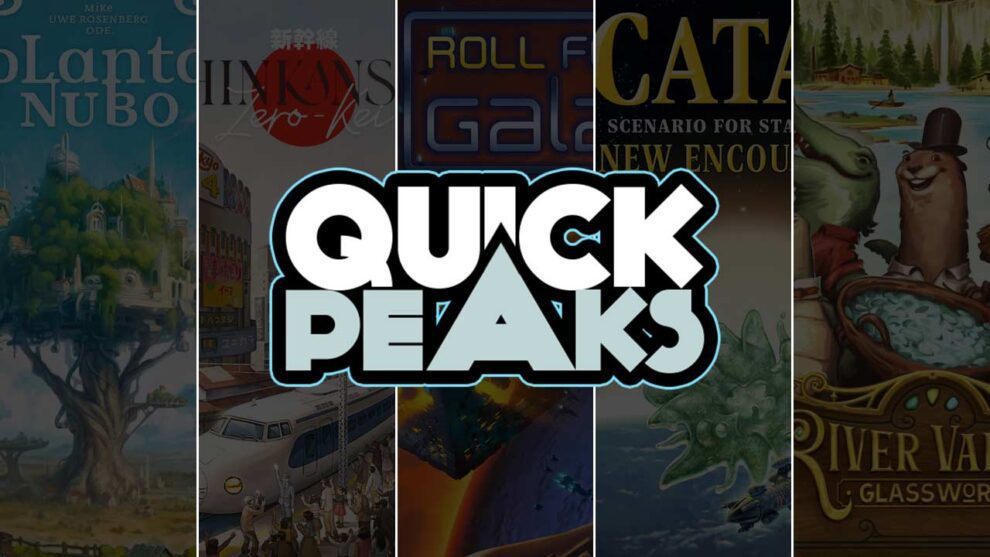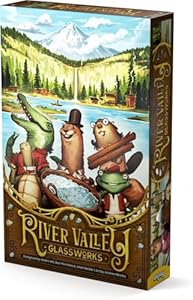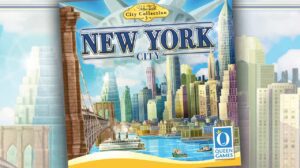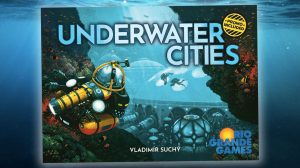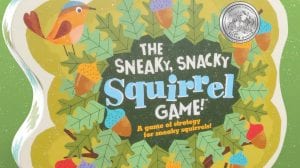Planta Nubo – David McMillan
There were only a handful of titles from Essen last year that I was really excited about, and Planta Nubo was up there towards the top of the list. I mean, a co-design between Michael Keller and Andreas “ode.” Odendahl (the co-designers of La Granja and El Burro) and the G.O.A.T. himself, Uwe Rosenberg (Agricola, Caverna, Bohnanza): what is there NOT to be excited about? Unfortunately, due to the logistics (and shipping!) involved, I wasn’t able to obtain a copy from Essen Spiel at the time. But, thanks to our friends at Devir Americas, I finally have a copy in hand and was able to play it for the first time recently.
Let me tell you, folks, it was worth the wait.
There’s a lot of things going on and, even after having read the rules and having watched several videos, my wife and I still found ourselves going back to the rule book during our first few turns to figure out the meanings of some of the iconography. By the third round, though, we had a good feel for the game and were able to progress more confidently to the finish line. We had a great deal of fun and I am excited to try Planta Nubo with more than just two players.
Watch out for my upcoming review.
Ease of entry?:
★★★☆☆ – There were a few questions
Would I play it again?:
★★★★★ – Will definitely play it again
Read more articles from David McMillan.
Shinkansen: Zero-Kei – Justin Bell
Any game designed by Llama Dice—the duo who gave us The Red Cathedral and The White Castle—is a must-own for me, so a few months ago I picked up their 2021 design Shinkansen: Zero-Kei through an online sale. I had a gap in review copies recently so I got this to the table with two members of my review group.
Shinkansen: Zero-Kei has a lot going for it. Short playtime, under an hour with three new players. It’s easy to teach, with a teach video from the publisher, Ludonova, that lasted eight minutes and that included the setup time. It prominently features trains (love train games) and Japan (love Japan). Scoring is easy and downtime is minimal.
But Shinkansen: Zero-Kei ultimately suffers the worst of fates: enjoyable, but not memorable. It is a classic “six out of ten” review, a term we use around here a lot because those are the toughest reviews to write. Actions are limited, and while I found ways to defend that with The White Castle, 15-18 actions in this game was not nearly enough to accomplish anything of value. Players are tasked with building a local train line for the 1964 Tokyo Olympics, but the actions are very vanilla: lay track, drop tokens into an area control portion of the board, build stations. The cardplay is fun, but there’s not much variety to how a game will play out.That left us in a tough place—I needed to know if the game was good based on the designer pedigree, but if I had played it at a convention, I would have shrugged my shoulders and moved on with my life.
Ease of entry?:
★★★★★ – No sweat
Would I play it again?:
★★★☆☆ – Wouldn’t suggest it, but would happily play it
Read more articles from Justin Bell.
Roll for the Galaxy – Bob Pazehoski, Jr.
Several rounds into the game, I finally said aloud what I had been thinking the whole game: Roll for the Galaxy is a game to play among trusted friends. Roll several dice behind a screen, fiddle with them in a private moment of selecting your primary action and aligning your dreams, and then reveal. What went on behind the screen? Once the dice are out, rounds unfold according to each player’s established rules and conditions—written in nearly unverifiable, tiny print on tiles across the table. Babysitters beware, because this is a game where you just have to believe the activity is on the up and up.
That said, Roll for the Galaxy has a lovely narrative tension for its tableau building. You want to use your finished tiles for bounty—cash and points. Of course, you first need to settle and develop the tiles to get them into production. And in order to do that, you’ll need to explore for access to the bag o’ tiles. And while it’s lovely to have a handful of dice to chuck behind that private screen, you have to manage your cash to keep them in action (or not if a tile happens to pay for such surface inefficiency). I liked the decision-making process and the obvious opportunities for engine-building. There were a few quirks here and there that made the introduction confusing, but really there’s so much to love here. I can see why so many love it.
Ease of entry?:
★★★☆☆ – There were a few questions
Would I play it again?:
★★★★★ – Will definitely play it again
Read more articles from Bob Pazehoski, Jr.
CATAN Starfarers – New Encounters – Tom Franklin
My weekly gaming group enjoyed CATAN: Starfarers. We have all played standard CATAN plenty of times and the shift to outer space, not to mention shaking those starships, made for a great twist on a familiar game.
CATAN: Starfarers – New Encounters is a set of three mini-expansions for CATAN: Starfarers. Each of the three scenarios focuses on a specific aspect of Starfarers, which sounds fine in theory. In practice, however, that focus is so heavy that it forces players to play a very different game—a game centered around the scoring goals of the Encounter instead of standard Starfarers.
We tried all three Encounters. After the third game ended, we agreed that one play per Encounter was enough and we put Starfarers: New Encounters away for good.
Ease of entry?:
★★★★☆ – The odd bump or two
Would I play it again?:
★☆☆☆☆ – Would play again but will cry about it
Read more articles from Tom Franklin.
River Valley Glassworks – Andy Matthews
I’ve been following Ben Pinchback, Matt Riddle, and Adam Hill’s games for years. They lean towards the crunchier side of the spectrum; with heavy roll and write games like Three Sisters, Fleet: The Dice Game, and French Quarter. But their newest release has gamers all abuzz with cozy vibes. River Valley Glassworks is, intentionally or not, a shot straight at games like Azul: family weight strategy games that can be played and enjoyed by serious and casual gamers alike.
In River Valley Glassworks, players act as one of 5 different critter-led businesses all trying to make their living by collecting beautiful glass from the river; tumbled and polished smooth by the water. And let me say the glass pieces (acrylic resin) are gorgeous. Organic shapes in 9 different colors, some solid, some translucent, and others clear with sparkles, depending on the rarity of each piece. Gameplay is dead simple: either place a piece along the river (matching by shape) in order to collect nearby pieces which you group on your board by color, or you can collect straight from the lake and place those pieces in your pan for future turns. The first to place 17 pieces on their player board triggers the end of the game. Scoring is straightforward as well, in fact your possible points are already printed on the board—you just collect points equal to the numbers where your glass pieces lay.
I love that board gaming is embracing the new “cozy” aesthetic with games like Flamecraft, Everdell, Verdant, Calico, and others. River Valley Glassworks settles into that group perfectly. So if you enjoy casual gameplay with great artwork, beautiful components, and clever gameplay, give this one a shot.
Ease of entry?:
★★★★★ – No sweat
Would I play it again?:
★★★★★ – Will definitely play it again


